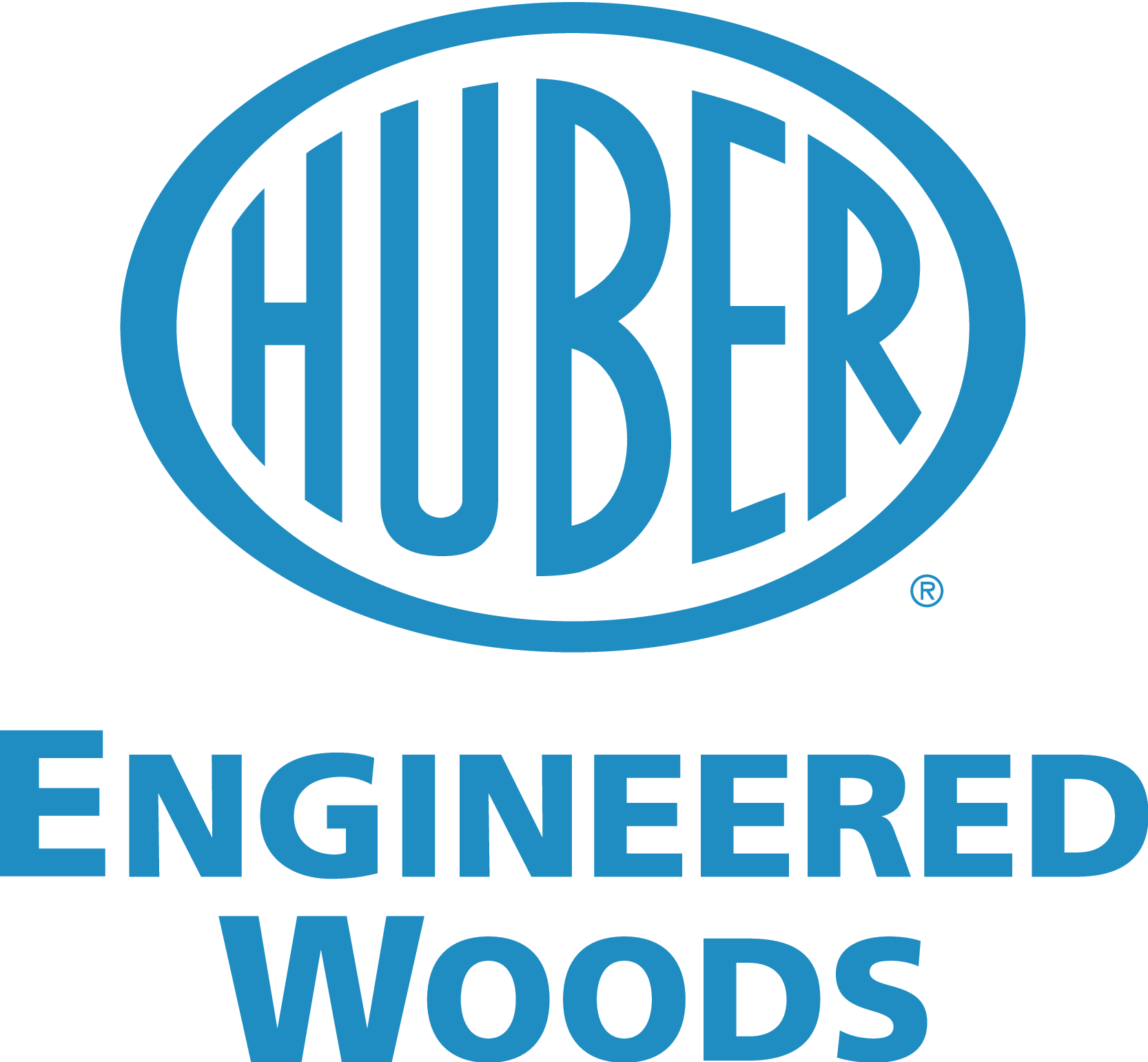This CE Center article is no longer eligible for receiving credits.
Alternative Solutions
Problems and drawbacks of conventional methods have led to alternative solutions.
Extruded Polystyrene Sheathing
This is a light weight alternative that is not a structural panel. It has no nail holding strength and can be easily punctured. The vapor permeance of extruded polystyrene sheathing is less than 3. It does have insulating properties and some types can be installed as a water-resistive barrier and air retarder with special detailing. Seams must be taped.
Roll- or Sprayed-On Water-Resistive Barrier
The primary advantage of this method is that it will stay on the wall without ripping or tearing. However, roll- or sprayed-on water-resistive barriers must be installed at a specific thickness, and there are different installation instructions for different substrates. Further, a dry time is required, multiple coats are often necessary, and there are temperature restrictions for installation. The surface must be clean before applications, and consistency is difficult to achieve. All in all, this method entails an exacting and time consuming installation process.
OSB Panel with Integrated Moisture Barrier
Rising energy prices, growing awareness of building performance, environmental sustainability, and changes in building codes have led to products that represent optimal solutions for structural sheathing, moisture management and superior air barrier performance. One such product that represents an optimal solution for moisture management is a structural panel like OSB and plywood but with an integrated durable moisture barrier. This continuous water and air barrier also improves energy efficiency by significantly reducing air leakage. Once the panels and tape have been installed, a lasting protective barrier has been established as a permanent part of the structural panel, making it impossible for water to become trapped between the panel and barrier.
These products are engineered with the optimal permeance to allow the wall system to breathe and dry out, while also preventing intrusion of exterior moisture. A water-resistive barrier must have a higher permeance than the OSB panel to allow for outward drying of the system. On the other hand, the barrier must not be overly permeable and allow exterior water vapor to enter the wall sheathing and system. This is a common issue when moist cladding such as brick, stucco or stone is exposed to heat from the sun. The vapor permeable-moisture barrier is 12-16 perms.
Seam sealing tape can be used as flashing tape, which minimizes the chance for flashing installation errors. Unlike with many conventional products, windy weather does not impede tape application. Some wall panels are also manufactured with a screen texture which provides added grip for ladders and handling as opposed to many housewraps which are smooth and slippery, creating a safety hazard for ladders leaning against the structure. Some manufacturers offer a 30-year system warranty. Properly installed, these panels and tape keep water from entering the wall system and provide a drainage plane to help water exit.
“Integrated wall sheathing was part of a 'perfect' wall assembly, providing our weather resistive barrier, air barrier, thermal barrier and drainage plane. Testing has shown that the seam sealing tape provides one of the toughest air barriers available. This system addresses the growing need to make buildings more durable and energy efficient,” says Architect Chris Laumer of Giddens LG Squared in Atlanta, Georgia.
Atlanta architect Jose E. Tavel agrees after use of the system on an architectural studio. “For the new studio we had interior and exterior walls panelized off-site with the system sheathing. The panels were delivered with the sheathing installed and the seams taped. Once the panels were erected, the final sheathing was installed very quickly and had the building watertight and on our way to the LEED Silver rating,” says Tavel.
In an added advantage, panels go up quickly for a stronger, drier, faster seal, creating the ideal building envelope. Installation is relatively easy and can be completed in two steps—fasten panels and tape the seams. The wall system is code recognized as a water-resistive barrier and a Type 1 air barrier. The roof system is code recognized as a roofing underlayment. All panel seams must be taped with the prescribed seam sealing tape.
The OSB roof panel with integrated moisture barrier can result in a streamlined roofing installation. The panels eliminate rework, and after roof system is taped, the building can be considered dried in and mechanical contractors can begin rough-in. The panels, which have a uniquely clean and uniform appearance, can be exposed for 180 days.
The products are only allowed in Type V construction and in construction permitted under IRC and IBC. Roof panels can only be used on roofs with a minimum 2:12 slope. The products are approved for adhesively-attached Exterior Insulation Finishing (EIF) systems.
Moisture and Air Leakage Management
Properly constructing a building envelope for optimum moisture and air leakage control leads to sustainable, energy-efficient buildings. As technology advances, buildings systems become more effective. One such example is the high-performance structural panel complete with integrated air and moisture barrier—a system that installs easily and accurately and performs reliably, providing architects with a valuable tool to achieve green buildings that save energy costs and maximize user comfort.
 |
Huber Engineered Woods LLC continually strives to create innovative products that suit their customers’ needs. Each one
delivers outstanding performance, easy installation, and greater strength in single family, multifamily, and light commercial
projects. Huber’s ZIP System® Roof and Wall Sheathing are structural wood panels with built-in protective barriers, eliminating
the need for building wrap or felt and providing a continuous rigid moisture and air barrier that optimizes energy efficiency.
Additionally, Huber’s AdvanTech® Subflooring product is proven to achieve a superior combination of strength and moisture
resistance—for subflooring that won’t swell, cup, delaminate, or bounce even under the toughest conditions.
Visit Huber’s new online architectural library to explore their offering of innovative, high-performance, and environmentally
responsible building solutions. On this site, you can quickly access and download all of the product information you need to
specify ZIP System® sheathing or AdvanTech® subflooring for your next project.
Visit www.HuberArchitectLibrary.com. |
A dry building is a durable building. Yet properly managing the movement of air and moisture across the building envelope has long bedeviled architects and builders. To effectively control the indoor environment for energy savings and occupant comfort, today's construction practices are moving to a tighter building envelope. In a tight building, heating and cooling efficiencies can be maximized and properly designed ventilation systems can effectively manage moisture levels and indoor air quality. These principles of high-performance building are common in nearly all current green building standards and construction codes, and performance improvements in air sealing and air exchanges are specifically rewarded through building codes and green rating systems such as the U.S. Green Building Council's Leadership in Energy and Environmental Design (LEED) program.
The traditional methods of managing moisture intrusion such as caulking, building felt, and house wrap are being replaced by high-performance panels with an integrated weather barrier that helps eliminate the risk of water becoming trapped between building wrap and sheathing, and is specially engineered to allow permeability, enabling the building to “breathe.” This article will address the physics of air and moisture infiltration into the building envelope and present a comparative discussion of traditional and contemporary methods of managing air, water, and moisture.
Moisture Management in Buildings
Moisture, in all its physical forms, is commonly regarded as the single greatest threat to a building's durability and long-term performance. When moisture infiltrates the building envelope, problems can occur: mold, mildew, rot, and corrosion which in turn can translate to maintenance problems, poor indoor air quality, and building system failure—factors that, in a worst-case scenario, may pose liability issues for building designers and owners.
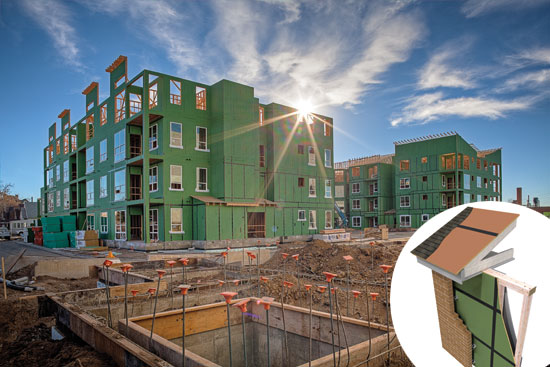
Image courtesy of Huber Engineered Woods
High-performance panels feature an integrated water-resistive barrier for effective moisture management.
In a building, moisture is transmitted through gross or liquid water, air, and vapor, in descending order of potential damage to a building envelope. Like all substances, water can exist in three phases: solid, liquid, and gas. A substance's phase essentially depends on the average speed of molecular motion. When water is a gas or vapor, the molecules are free to move about—they “run free.” In liquid water, the molecules are attached to each other; this allows liquid water to assume the shape of its container. Bulk water—rain, runoff, and other flows—is driven primarily by gravity and also by capillary action, or wicking, which is the ability of a liquid to flow in narrow spaces without the assistance of, and in opposition to, external forces like gravity. This can cause water to enter through very small gaps, e.g. between flashings and a cladding. Moisture vapor diffuses into and through a wall according to moisture and temperature gradients—that is from a region of high vapor concentration to a region of low vapor concentration, and from the warm side of a wall to the cooler side.
In terms of presenting risk to a building assembly, not surprisingly, liquid water carries the greatest risk. Driven by gravity or air pressure differences, water in liquid form can be carried into a building through holes and cracks. Air carrying water vapor moves with air, and carries a moderate risk. The lowest risk is presented by vapor, which moves through the air.
It is important to note here that walls and roof systems are very similar, and layers that make up both are essentially the same, and the concepts discussed—water, air, and vapor management—will apply to both systems.
Liquid Water Control Strategies—The Four Ds
Moisture can and will get into a structure—and fast. Liquid water can move through brick in about 20 seconds. Because water does get behind all facades, it is advisable to have a good secondary water barrier. Four key strategies, known as the Four Ds, keep moisture from getting into a building. They can be applied at the level of design and the level of detail. Essentially the Four Ds are predicated on the following two notions: The principal objective is to prevent moisture from getting into the structure in the first place (deflection); but any moisture that does get into the structure must be managed as quickly and thoroughly as possible (draining, drying, and durability).
Deflection. Keeping rainwater off the wall and other main entry points is the first line of defense. If water cannot reach a joint or junction, the possibility of leaks is greatly reduced. The first means of deflection is in the design of large roof overhangs, peaked roofs, and/or a face-sealed approach. Overhangs and peaked roofs have been shown to reduce rain deposition by 50 percent. Attention should be paid to drip edges, which help deflect water away from the structure.
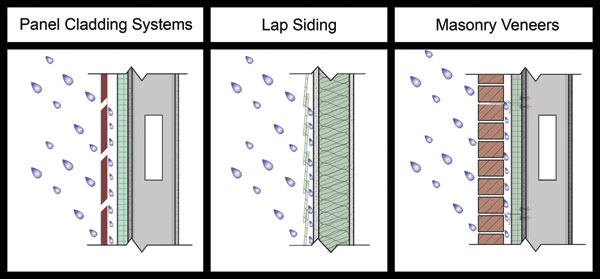
Image courtesy of Huber Engineered Woods
Allowing for drainage is the method used for water that is not deflected away from the structure and/or enters into the wall assembly.
Drainage. Water must be able to drain off the face of the building. In a wall assembly, drainage involves methods that move water out of the wall; any water that penetrates the exterior cladding must be drained back out via drainage paths specifically designed into the wall assembly. A typical drainable wall system controls water infiltration through kinetic energy (raindrop momentum), gravity, surface tension, and capillary action. In order to create effective drainage within a wall assembly, the following elements should be incorporated into the design: screen or cladding; a primary water shed layer (for deflection); a secondary water-resistive barrier; a drainage plane, or a water-repellent plane; a drainage gap, which is often a clear air space; and weep holes or flashing at areas of interruption and at the base. With no weep holes, water gets trapped behind the facade and can't drain out. In some cases, the water can be wicked up through the exterior cladding.
Drainage mats are also available as a method to create a clear, drainable space. As can be seen in the accompanying illustration, brick veneer should be back ventilated to flush inward-driven moisture out of the assembly. The recommendation of a drainage plane has been commonplace, but most building scientists are now pushing for an air gap as well. A clear air space should be provided that is open at both the bottom and top of the plane, the theory being that an air gap will allow for drying (through convection) should moisture penetrate the exterior cladding or allow an unobstructed space for water to drain out should there be a leak higher up the wall assembly. An air gap for brick is common, and air gaps can easily be created with furring strips for most exterior claddings. Generally, a ¼-inch gap is recommended to prevent capillary action.
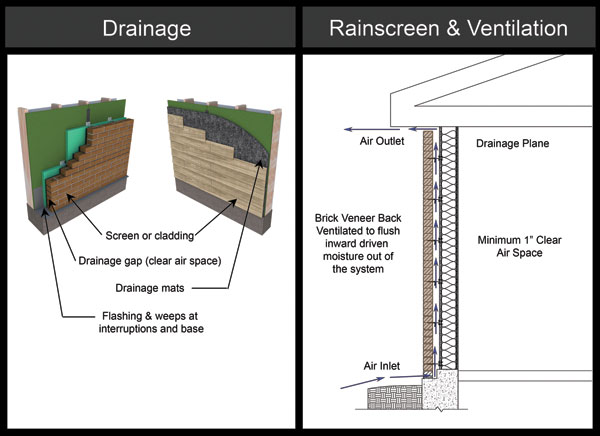
Image courtesy of Huber Engineered Woods
For best results, drainage details should be carefully considered.
Drying. Water that cannot be drained immediately should be dried as quickly as possible principally through diffusion and ventilation. The drying potential of a wall is affected by several factors including evaporation rate from surfaces; vapor movement by diffusion or air leakage; drainage by gravity and convection; and air movement. The key thing to note here is that when the wetting rate exceeds the drying rate, problems accrue. In order to maximize drying potential, air gaps should be utilized as should products that don't absorb water and products that let liquid water readily pass through them.
Durability. The moisture tolerance of the materials in the wall assembly is a key consideration, with architects well advised to select exterior cladding and wall assemblies that meet durability requirements of the prevailing building code. Durable materials are a fourth line of defense when the others—deflection, drainage, and drying—have failed. Some claddings, like brick veneer, are inherently durable, while others may require an exterior finish.
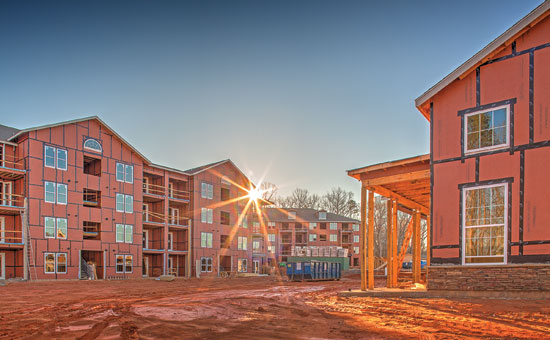
Image courtesy of Huber Engineered Woods
The OSB panel with integrated moisture barrier results in a streamlined installation and superior moisture management.
Most mistakes occur under the drainage category with the use of improper flashing, ineffective water-resistive barriers, and non-continuous air barriers. By this time, many designers realize that avoiding vapor barriers is important.
Air Leakage and Thermal Performance
Next to stopping rain, the second most important job of a building enclosure is to stop air leaks, which can also compromise the durability of a structure. Uncontrolled air flow not only introduces moisture that can cause rot and mold, it can increase energy use and indoor air quality problems. Proper sealing between wall assembly components prevents unwanted air movement that washes through insulation and degrades the effective R-value. Without effectively sealing the building envelope, insulation cannot perform properly.
There are three different types of air flow: diffusion, in which air simply moves through the material and does not need a hole for entry; orifice flow, in which air comes in one area, follows the same paths, and moves out at the end of that path; and channel flow, in which air comes in one area, moves around, and exits in another area. With all of these types, there are plenty of areas and opportunities for air leakage, a scenario that requires an effective building envelope.
Building Envelope—A System of Many
The building envelope can be thought of as “a system of many.” Many variables exist that determine its performance. There are, for example, many components—exterior walls, foundations, roof, windows, and doors—as well as many penetrations in these components and many interfaces between them. Further, building envelope performance is impacted by many subsystems, including heating, cooling and ventilating equipment, plumbing and electrical systems, and many different types of activities of the building occupants. It is important to note, however, that no one product can control air leakage Air tightness is a function of the entire building envelope, and everything must work together in order to achieve effective air tightness. Even with a great air barrier system like a peel n' stick or taped wall joints, for example, air can still flow right through improperly flashed penetrations or leaky windows and doors.
The airtightness of a building envelope cannot be overestimated, however. A building's energy efficiency, occupant comfort, and sustainability quotient depend on it.
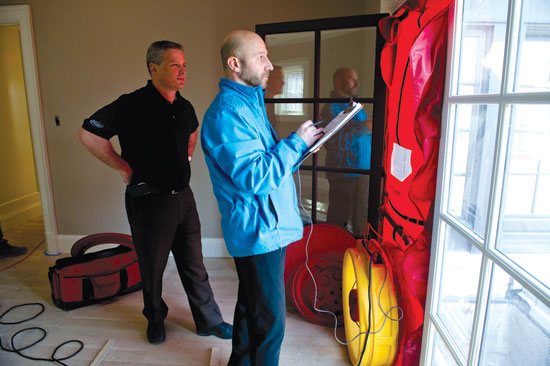
Image courtesy of Huber Engineered Woods
Blower door tests are the only satisfactory way to measure air tightness and highlight areas of heat loss.
Convective Loops
Today, the most commonly used insulation is still fiberglass batts, which offer a relatively low cost for the function it performs. As most insulation subcontractors are paid by the square foot, there is an incentive to install as much insulation as possible in a small amount of time, a scenario that leads to voids or gaps in the wall cavity that are not filled with insulation. With these voids, air can begin to travel around the insulation and sometimes within the insulation because its density is so low. If there is an effective air barrier on the outside of the building, this won't happen. The result is a reduction in the performance of the insulation or loss of R-value.
Consider the case of convection loops, which can form within wall assemblies from the warming and rising of air near the warm side of the assembly and the cooling and dropping of air near the cold side of the assembly. Uncontrolled air movement accelerates heat loss through convection. Air barriers prevent heat loss through convection.
Air flow often affects the performance of low-density fiber insulation. Air movement can compromise the thermal performance via wind washing, which occurs when wind enters and exits at different locations of the building envelope. The accompanying graph summarizes experimental measurements showing the effect of air infiltration on the installed R-value of the fiberglass insulation: about 50 percent of the insulation R-value is lost at 5mp wind speed if the insulation is not protected by an air barrier.
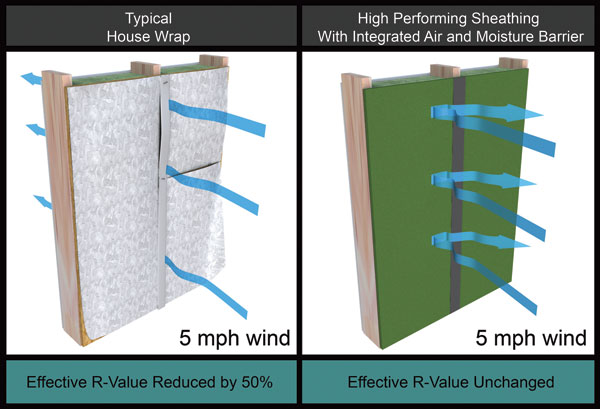
Image courtesy of Huber Engineered Woods
While in the event of a 5mph wind, with a typical house wrap the effective R-value is reduced by 50 percent, though it remains unchanged with high performing sheathing.
Air Barrier Systems—Preventing Air Flow Through the Wall
Air sealing the building envelope is one of the most critical features of an energy-efficient building. Preventing unwanted air flow, an air barrier system is composed of materials that form and seal floors, walls, and ceilings to prevent unwanted air movement. To be effective, the system must be continuous with no holes, openings, or penetrations and resistant to air pressure differentials. Durability, strength, and impermeability are also key factors as well as sufficient stiffness to allow adhesion. To be effective air barrier system components—including panels and tape—must have passed the air tightness requirements as set forth in the stringent air barrier assembly testing standard (ASTM E 2357) by the Air Barrier Association of America (ABAA). The effectiveness of tape and tape and flashing adhesion, while of prime importance, is often discounted in articles on air barriers. As those in the industry like to joke, tapes should be used to create an air barrier that will “peel n' stick, not stick n' peel.”
Testing for Air Leaks
Tests have been developed to measure how effectively an air barrier system prevents unwanted airflow. Professional energy auditors use blower door tests to help determine a structure's airtightness—these tests are the only satisfactory way to measure air tightness and highlight areas of heat loss.
A blower door is a powerful fan that mounts into the frame of an exterior door. The fan pulls air out of the house, lowering the air pressure inside. The higher outside air pressure then flows in through all unsealed cracks and openings. Air leaking into the house from outside can be detected using a smoke pencil. According to the U.S. Department of Energy, there are two types of blower doors: calibrated and uncalibrated. Auditors should use a calibrated door, which has several gauges that measure the amount of air pulled out of the structure by the fan. Uncalibrated blower doors can only locate leaks in buildings, and they offer no method for determining the overall tightness of a building. On the other hand, the calibrated blower door's data allow the auditor to quantify the amount of air leakage and the effectiveness of any air-sealing job.
Energy auditors may also use thermography, or infrared scanning, to detect thermal defects and air leakage in building envelopes in conjunction with a blower door test. The accompanying illustration shows thermal, or infrared, image that indicates air leakage at the bottom of a wall and through an electrical outlet.
Ways to Improve Air Tightness
Architects have various strategies to improve air tightness of the building envelope.
Caulk and foam gaps and seams. Probably the most common products for creating an airtight barrier are tapes, gaskets, caulks, and spray foam materials. Caulking is a simple, effective air-sealing technique that is generally used for cracks and openings between stationary building components such as around door and window frames. Special care needs to be taken when using spray foams, as some expand more than others and some can exert significant pressure on the surrounding structure during expansion.
Building wraps. Provided all seams, edges and details are sealed, and that it is caulked at the bottom, building wraps can help decrease air leakage. A good building wrap material must provide waterproof protection and have a high moisture vapor transmission rate to be considered effective. Some newer building wrap designs are susceptible to ripping or tearing and must be handled carefully. Intended to be installed over the sheathing and behind the siding, whether the siding is brick, vinyl, concrete or any other material, building wrap will stop or reduce moisture infiltration and reduce the water condensation or mold problems getting into the studs or wall cavity.
Peel n' stick air barriers. Squares or rectangles of roofing underlayment with adhesive backing that is peeled off and the underlayment pressed into place are considered a superior option for ice and water barriers. Peel-n-stick underlayments can be a first layer on potentially problematic areas, or installed on the entire roof if it is low slope or flat. However, the adhesive is temperature-sensitive until securely bonded to a dry surface, and many of the materials are slippery, and unsafe to walk on directly after application.
Taped wall sheathing panels. All-in-one sheathing panels are a good choice for improving air tightness. The taped sheathing panels form a continuous protective air barrier, significantly reducing air leakage through walls or roofs and lowering air changes per hour. This helps optimize R-value, save energy, and meet increasingly stringent performance requirements of energy codes and green building programs.
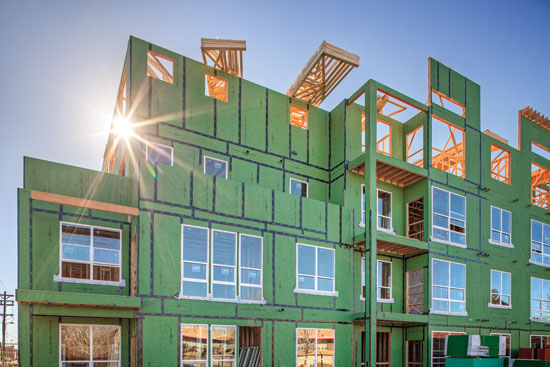
Photo courtesy of Huber Engineered Woods
All-in-one sheathing panels are a good choice for improving air tightness.
Vapor Management
As mentioned previously, water can take many forms and water in its liquid state is not the only concern in managing moisture in a building. Water as vapor can also cause problems, especially when it becomes trapped in an assembly and turns to liquid, that is condensation, and wets structural assemblies. Water vapor moves by only two mechanisms—air transport and vapor diffusion. Of these two, air movement accounts for more than 98 percent of all water vapor movement in building cavities, according to the U.S. Department of Energy. Consequently, in most homes, managing air infiltration and exfiltration will be more important.
The air contains a certain amount of moisture, or water vapor, which depends on its temperature and relative humidity. Hot air could hold more moisture than cold air, hence air currents could carry significant amount of moisture into the building enclosure. Air-transported moisture must not be confused with vapor diffusion, though. Diffusion is the slow molecular movement of water vapor through porous materials and assemblies. In order for diffusion to occur there must be a driving force and a pathway. The driving force is the difference in water vapor concentration or difference in vapor pressure across an assembly; diffusion occurs through vapor permeable materials from an area of higher concentration (higher vapor pressure) to an area of lower concentration (lower vapor pressure).
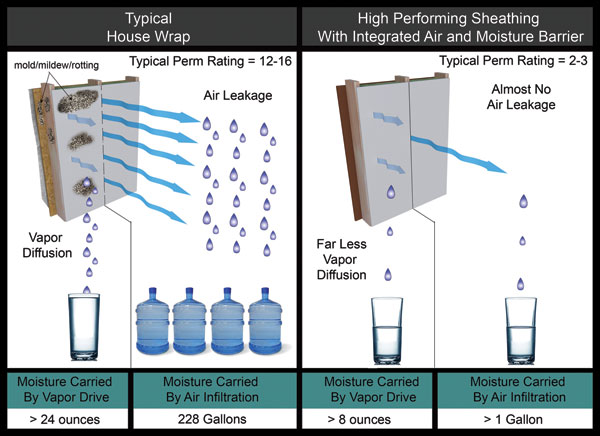
Image courtesy of Huber Engineered Woods
High performing sheathing with an integrated air and moisture barrier has far less vapor diffusion than a typical house wrap.
The accompanying illustration demonstrates magnitude of vapor carried by air versus vapor diffusion—a key reason to create an effective air barrier, not just for infiltration purposes but for vapor management as well.
In new construction, vapor retarders, or vapor barriers, can be installed to reduce vapor diffusion into the building assemblies. This is where “perm” ratings become applicable—the key physical property which distinguishes vapor diffusion retarders from other materials is permeability to water vapor. Materials which retard water vapor flow are said to be impermeable. Materials which allow water vapor to pass through them are said to be permeable. A question becomes, which perm rating is right for a water-resistive barrier? There should be a balance: A water-resistive barrier should have enough permeability to allow the wall system to adequately dry out but not so much permeability that excess water vapor is allowed into the system from the outside. A water-resistive barrier should have enough permeability to allow the wall system to adequately dry out, but not so much permeability that excess water vapor is allowed into the system from the outside. Many building codes define a vapor diffusion retarder as a material that has a permeability of one perm or less as tested under a dry cup test method. The sweet spot is considered 10 ≤ Perm Rating ≤ 20.
Solar Vapor Drive
Inward vapor movement due to solar radiation is known as solar vapor drive. Essentially what this means is that a wet surface that is heated by the sun will develop a high vapor pressure, and this can force moisture to be driven into absorbent materials.
While traditionally the prime concern was wind driven vapor drive, in today's buildings, most of which have air conditioning, vapor diffusion from outdoors can constitute an even greater problem. In addition, inward driven solar vapor drive, from the outside in, is potentially more problematic in producing mold and rot than winter vapor drive. While vapor drive will occur with higher humidity on one side of a wall, the sun is a very powerful engine that will drive moisture through most wall components. If the wall components were poorly chosen, inward vapor solar drive, can pose a substantial threat. Exterior walls must be completely sealed to prevent vapor or air from entering, which is not an easy task. Architects should never use a material on the interior that will trap moisture in the wall, like poly or vinyl wallpaper. Further, water-resistive barriers with high perm ratings can allow too much vapor to pass into the building envelope. It is better to use a forgiving water-resistive barrier that will still allow moisture to escape, but not allow too much moisture to be driven inside—this would decrease comfort levels and energy savings as the HVAC has to work harder to dehumidify moisture laden air.
The accompanying clearly illustrates the dynamics of solar vapor drive.

Image courtesy of Huber Engineered Woods
A wet surface that is heated by the sun will develop a high vapor pressure, and this can force moisture to be driven into absorbent materials.
Pitfalls of Today’s Control Methods
Careful attention must be paid to the installation of traditional control methods. Problems are a certainty with improper installation.
Water-Resistive Barrier
A water-resistive barrier is a thin membrane intended to resist liquid water that has penetrated behind the exterior cladding. A few rules of thumb must be followed. Proper installation is critical. Water must remain outside of the protective wrap. If installed properly, a water-resistive barrier may improve a structure's overall moisture efficiency and performance by acting as a secondary moisture drainage plane. Water-resistive barriers withstand bulk water penetration and wind-driven rain that penetrates the exterior cladding from intruding into the wall assembly. Water will be channeled down the outside surface of the water-resistive barrier, thus reducing the potential for condensation build-up in the wall assembly which reduces the likelihood of moisture problems, rot, and degradation. Water-resistive barriers come in a variety of widths and lengths as well as a variety of materials. These materials consist of polymeric-based sheets (plastic) and can include spun-bonded (fibers), cross-woven (tapes), film (sheets) or a combination thereof.
Roll or Spray-On Products
With these products, it can be difficult to achieve the proper mil consistency. There is inefficiency due to the fact that multiple layers of coating are required. The required cure time makes for a slower installation process.
Grade D Building Paper
This product does not function well as air barrier/retarder. In addition, this product is prone to tear easily, particularly if left exposed, and can be difficult to install in windy conditions.
Building Wrap
In order to function as an effective air barrier, all seams, holes, and penetrations in the building wrap must be properly sealed (including the bottom), a time consuming and laborious process. Building wrap also suffers from drawbacks of Grade D building paper, notably, it is prone to tear if left exposed, and is difficult to install in windy conditions. There is poor adhesion of flashing material and tape as well as complex and ever-changing flashing, repair, and installation details to accommodate in order to effectively deploy building wrap.
Generally speaking, these control layers must be installed properly or they can be more detrimental than beneficial. Problems range from product function and quality to complex and conflicting installation details. Some wraps and papers are of poor-quality regardless of how they are installed. Many perforated wraps, for example, result in the passage of water and air or have low abrasion and tear resistance. In macro porous perforated housewraps, the dilemma is that the macro holes in the film provide vapor permeance, but sacrifice air and water resistance. With micro-porous perforations, the conundrum becomes whether the material is sufficiently abrasion and tear resistant. Asphalt papers and felts, on the other hand, may be more moisture absorbent but less pliable.
As a result of the difficulty of installing building wrap or conventional systems, several problems can occur, including reverse flashing; building wrapped tucked into the building; improperly flashed penetrations; and flashing tape that doesn't stick. With cladding such as stone and stucco, numerous steps are required. Note that code requires two layers of Grade D paper for direct applied stone or three-coat stucco over wood based sheathing. The necessary layers include wood sheathing; a first layer of grade D paper or wrap (drain plane); a second layer of paper or wrap (bond break); wire mesh; brown coat, a scratch coat, and a finish coat.
Dried In Roof
Drying in is making a building impervious to the rain by protecting it with roofing underlayment, at least a layer of felt or a building wrap product. This is a critical step in construction as once the roof is dried in, electrical, plumbing and HVAC may begin rough installation. If the roofing felt blows off, the building is not dried in, and this causes delays in other trades. In a National Association of Home Builders survey, nearly one quarter (23 percent) of respondents cited absence of or damaged felt as a problem. Even if a small area of roof were exposed, problems could occur in between decking and felt installation. Because two trades are involved, there is a break between processes and if it rains, snows, etc. during this time, the roof goes unprotected. Felt is also difficult to install, especially on higher structures as installers have to climb up and down the building to transport rolls of felt, which constitutes a potential safety issue.
Alternative Solutions
Problems and drawbacks of conventional methods have led to alternative solutions.
Extruded Polystyrene Sheathing
This is a light weight alternative that is not a structural panel. It has no nail holding strength and can be easily punctured. The vapor permeance of extruded polystyrene sheathing is less than 3. It does have insulating properties and some types can be installed as a water-resistive barrier and air retarder with special detailing. Seams must be taped.
Roll- or Sprayed-On Water-Resistive Barrier
The primary advantage of this method is that it will stay on the wall without ripping or tearing. However, roll- or sprayed-on water-resistive barriers must be installed at a specific thickness, and there are different installation instructions for different substrates. Further, a dry time is required, multiple coats are often necessary, and there are temperature restrictions for installation. The surface must be clean before applications, and consistency is difficult to achieve. All in all, this method entails an exacting and time consuming installation process.
OSB Panel with Integrated Moisture Barrier
Rising energy prices, growing awareness of building performance, environmental sustainability, and changes in building codes have led to products that represent optimal solutions for structural sheathing, moisture management and superior air barrier performance. One such product that represents an optimal solution for moisture management is a structural panel like OSB and plywood but with an integrated durable moisture barrier. This continuous water and air barrier also improves energy efficiency by significantly reducing air leakage. Once the panels and tape have been installed, a lasting protective barrier has been established as a permanent part of the structural panel, making it impossible for water to become trapped between the panel and barrier.
These products are engineered with the optimal permeance to allow the wall system to breathe and dry out, while also preventing intrusion of exterior moisture. A water-resistive barrier must have a higher permeance than the OSB panel to allow for outward drying of the system. On the other hand, the barrier must not be overly permeable and allow exterior water vapor to enter the wall sheathing and system. This is a common issue when moist cladding such as brick, stucco or stone is exposed to heat from the sun. The vapor permeable-moisture barrier is 12-16 perms.
Seam sealing tape can be used as flashing tape, which minimizes the chance for flashing installation errors. Unlike with many conventional products, windy weather does not impede tape application. Some wall panels are also manufactured with a screen texture which provides added grip for ladders and handling as opposed to many housewraps which are smooth and slippery, creating a safety hazard for ladders leaning against the structure. Some manufacturers offer a 30-year system warranty. Properly installed, these panels and tape keep water from entering the wall system and provide a drainage plane to help water exit.
“Integrated wall sheathing was part of a 'perfect' wall assembly, providing our weather resistive barrier, air barrier, thermal barrier and drainage plane. Testing has shown that the seam sealing tape provides one of the toughest air barriers available. This system addresses the growing need to make buildings more durable and energy efficient,” says Architect Chris Laumer of Giddens LG Squared in Atlanta, Georgia.
Atlanta architect Jose E. Tavel agrees after use of the system on an architectural studio. “For the new studio we had interior and exterior walls panelized off-site with the system sheathing. The panels were delivered with the sheathing installed and the seams taped. Once the panels were erected, the final sheathing was installed very quickly and had the building watertight and on our way to the LEED Silver rating,” says Tavel.
In an added advantage, panels go up quickly for a stronger, drier, faster seal, creating the ideal building envelope. Installation is relatively easy and can be completed in two steps—fasten panels and tape the seams. The wall system is code recognized as a water-resistive barrier and a Type 1 air barrier. The roof system is code recognized as a roofing underlayment. All panel seams must be taped with the prescribed seam sealing tape.
The OSB roof panel with integrated moisture barrier can result in a streamlined roofing installation. The panels eliminate rework, and after roof system is taped, the building can be considered dried in and mechanical contractors can begin rough-in. The panels, which have a uniquely clean and uniform appearance, can be exposed for 180 days.
The products are only allowed in Type V construction and in construction permitted under IRC and IBC. Roof panels can only be used on roofs with a minimum 2:12 slope. The products are approved for adhesively-attached Exterior Insulation Finishing (EIF) systems.
Moisture and Air Leakage Management
Properly constructing a building envelope for optimum moisture and air leakage control leads to sustainable, energy-efficient buildings. As technology advances, buildings systems become more effective. One such example is the high-performance structural panel complete with integrated air and moisture barrier—a system that installs easily and accurately and performs reliably, providing architects with a valuable tool to achieve green buildings that save energy costs and maximize user comfort.
 |
Huber Engineered Woods LLC continually strives to create innovative products that suit their customers’ needs. Each one
delivers outstanding performance, easy installation, and greater strength in single family, multifamily, and light commercial
projects. Huber’s ZIP System® Roof and Wall Sheathing are structural wood panels with built-in protective barriers, eliminating
the need for building wrap or felt and providing a continuous rigid moisture and air barrier that optimizes energy efficiency.
Additionally, Huber’s AdvanTech® Subflooring product is proven to achieve a superior combination of strength and moisture
resistance—for subflooring that won’t swell, cup, delaminate, or bounce even under the toughest conditions.
Visit Huber’s new online architectural library to explore their offering of innovative, high-performance, and environmentally
responsible building solutions. On this site, you can quickly access and download all of the product information you need to
specify ZIP System® sheathing or AdvanTech® subflooring for your next project.
Visit www.HuberArchitectLibrary.com. |











